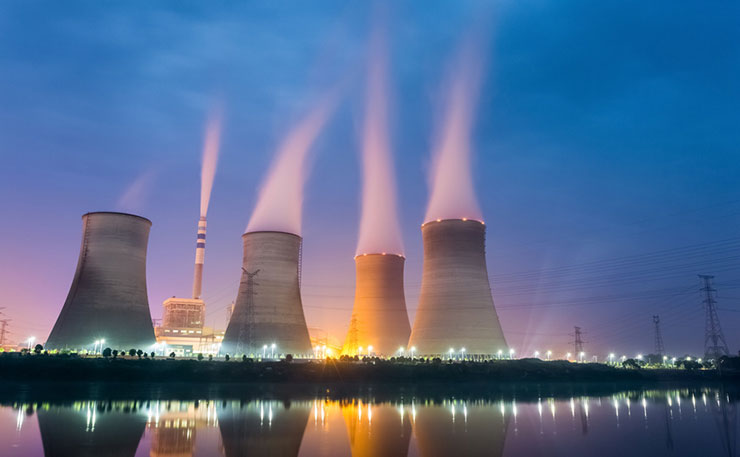The use of nuclear power to address climate change is, for many people, a contentious concept and for some their response will be hostile and incredulous.
As a “baby boomer” my own journey into advocacy for nuclear power hopefully helps explain why its immediate adoption is essential to saving our civilisation and environment.
My concern about climate change was ignited in 2005 when climate change awareness was growing and people were angry. We had a general revulsion against consumerism and rampant consumption. Corporate greed and ineffectual politicians were the enemies of the people and the environment and renewable energy solutions were thought to restore some level of control over our lives and return us to living in harmony with nature.
A wave of behavioural doctrines and solutions spread through the climate change movement. I researched alternative energy solutions and found that rarely was any analysis done to justify their adoption. At times perverse outcomes have resulted.
A notable example is that of biofuels, where markets have determined that more money can be made by displacing food production or by destroying tropical habitats, especially of the Orangutan.
But regardless of the evident failure of “renewables” to make any real dent in our greenhouse gas emissions, the ‘back to nature’ movement would brook no opposition. For some, science and technology were seen as a part of this attack on our environment, and so, conceptually straightforward technologies harvesting nature’s free energy became the vogue.
Typically we saw the large scale adoption of de-centralised power systems, such as roof top solar. The intermittency of these systems – which entrench the use of emissions intensive gas turbines – was and remains an inconvenient truth.
We will only get one chance to refashion our economy around low carbon technologies, and people need to be held accountable for their opposition especially when it has no analytical basis.
Typically terms such as “sustainability” are frequently used without any reference to careful life cycle analysis that really should be carried out to justify their validity.
As James Hansen has recently observed:
“People who entreat the government to solve global warming but only offer support for renewable energies will be rewarded with the certainty that the US and most of the world will be fracked-over, coal mining will continue, the Arctic, Amazon and other pristine public lands will be violated, and the deepest oceans will be ploughed for fossil fuels.
Politicians are not going to let the lights go out or stop economic growth. Don’t blame Obama or other politicians. If we give them no viable option, we will be fracked and mined to death, and have no one to blame but ourselves.”
I detect similarities in science denial between the anti-nuclear power brigade and the climate change sceptics.
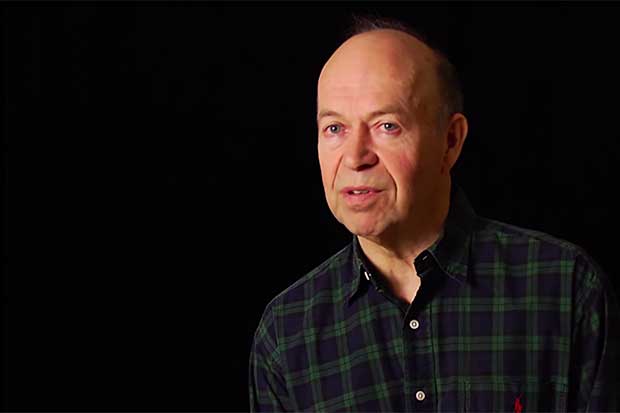
Again as James Hansen points out “There is no reciprocity from the supporters of renewable energy” with their preferred option being fossil fuel backup of renewable energy. “In other words replace carbon free nuclear power with a dual system, renewables plus gas. With this approach CO2 emissions will increase and it is certain that fracking will continue and expand into larger regions.”
The case I am making is for a clean, low carbon industrial future being in harmony with and nurturing nature. And I recommend reading the “Ecomodernism” thoughts of the Breakthrough Institute at for it is nature in the wondrous cosmic events such as the implosion of giant stars that gave our planet those elements essential to life, such as iron, chromium, molybdenum or cadmium.
These were created when stars in their final death throes fashioned and expelled these elements, along with uranium and thorium, into the cosmos. By a massive fluke, these then aggregate into structures such as the Earth to enable life to flourish.
Mankind’s creativity can harness these elements from the magic furnace of the cosmos and use them to protect rather than assault our environment.
My desire is to stop the industrialisation of our landscapes and to never entertain the massive and “unsustainable” network of towers and transmission lines that typify wind farms and solar plants.
In an increasingly stressed landscape I wish to see nuclear-powered desalinated seawater pumped inland so that we can remove many of the dams currently choking our increasingly climate stressed rivers.
As an engineer, I became concerned that harvesting wind and solar power could not provide the amount of energy required to refashion our industrial economy around low carbon technologies. Nor could they do it in the time frame or within the carbon budgets that are required.
We know the targets. We’ve been told often enough that a stabilisation target of 450ppm carbon dioxide equivalent gives about a 50 per cent chance of limiting global mean temperature increases to 2 degrees. This means Australia would need to reduce its annual emissions by 90 per cent by 2050, which means that our electricity must be generated with emissions less than 90 grams per kilowatt hour.
A quick review of Australia’s energy consumption shows where our efforts need to be directed if we are to address our emissions by 2050.
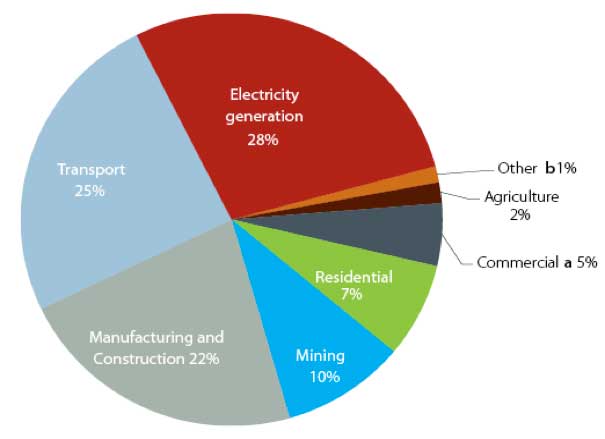
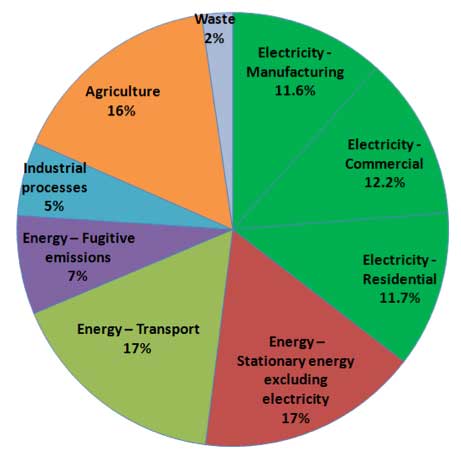
A comparison of our primary energy use in Figure 1 with our sectoral carbon emissions in Figure 2 shows that to make any meaningful reductions we need to be synthesising transport fuels and changing the ways we process metals or manufacture cement.
Importantly, we need to drive carbon out of our electricity generation. It’s no good claiming that we need to de-industrialise or have large cut backs on consumption. The scale of the industrial transition required to achieve a low carbon economy will dwarf our current production.
Meaningful reductions will, for example, result in the use of hydrogen or molten electrolysis to replace coal in the smelting of steel with the result that carbon dioxide emissions are eliminated.
Likewise aluminium, known as “canned electricity” has to be smelted using massive amounts of reliable, clean, low carbon electricity. Our heavy road transport needs to move to electrified rail and our light car fleet converted to electricity.
It’s obvious that we have not even started the process of real carbon reductions and all this needs to be done with speed and with massive energy density.
We will only get one go at transforming our energy base and any system that is unproven or has massive redundancy and does not stand up to analytical rigor must be excluded. No nation has yet made any significant greenhouse gas reductions using wind or solar power, and certainly not with expensive storage systems.
France and Sweden are two standout examples whose nuclear powered electricity generation meets the levels required by 2050. This has resulted in electricity being generated with carbon emissions of 71 and 22 grams of CO2 per kilowatt hour versus our 992.
France achieved their transition in 22 years with almost double Australia’s generating capacity. The contrasts of two neighbours in Germany and France could not be more stark – refer to Figure 3 and Figure 4 with France producing electricity with about one tenth of Germany’s emissions.
Germany has gone down a failed intermittent renewables route, and the risks to Australia if we follow this route as shown in Figure 5 are obvious.
We have on this planet enough uranium to power the globe for tens of thousands of years. Nuclear power stations utilise materials some 20 times more efficiently than wind or solar power and in nations that embrace the technology. 1200 megawatt reactors are now built in around 4 years.

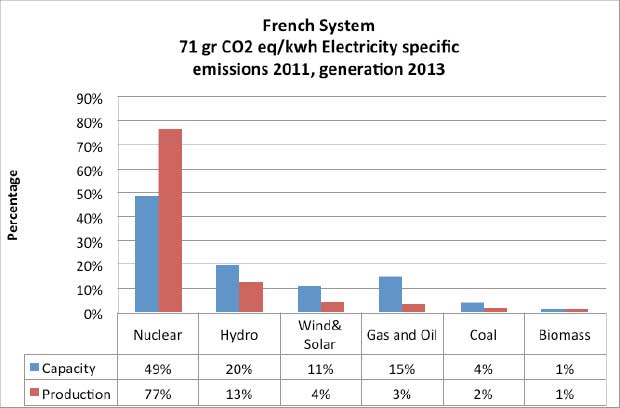
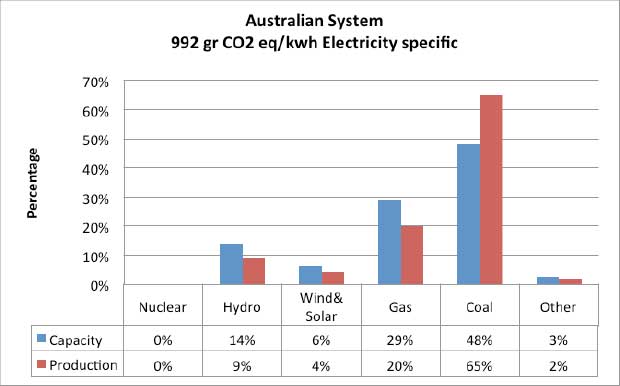
Efficient or “Sustainable” resource use
Another measure of the benefit of nuclear power versus intermittent renewables is the energy society invests in the system compared to the energy obtained. The economic efficiency and wealth of a society strongly depend on the best choice of energy supply techniques, which involves many parameters of quite different significance.
The “energy returned on invested”, EROI (often also called ERoEI), is a most important parameter because it describes the overall life-cycle efficiency of a power supply technique, independent from temporary economical fluctuations or politically motivated influence.
The EROI answers the simple question, “How much useful energy do we obtain for a certain effort to make this energy available”. The calculation of these numbers can be somewhat subjective because its calculation is highly dependent on the boundary conditions, however nuclear performs very well in most comparisons.
One well-documented German study by Weissbach and others found that nuclear power’s EROI of 75 units shows a clear benefit over the lower returns for wind of only 16 for and 4 for solar for each unit invested.
The results of this study are summarised in Figure 6 – EROI for electricity generating systems.
We see that society obtains more energy for an equal resource allocation from nuclear power than just about any other power system. The lower values for wind and solar reflect what we intuitively expect for diverse low energy intense sources of energy.
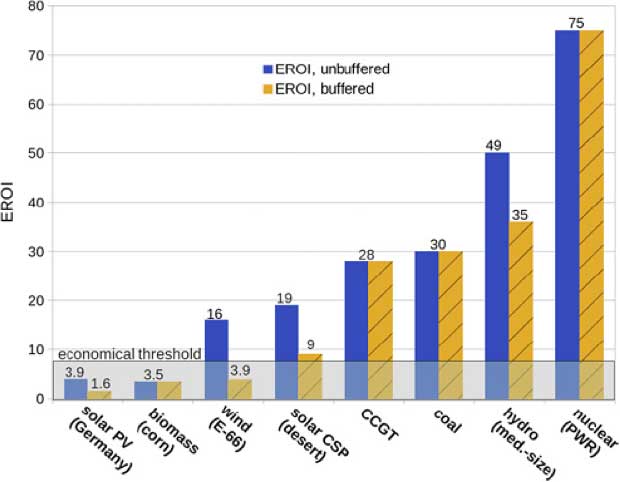
Characteristics of carbon abatement
If we are to achieve meaningful emissions reductions in Australia we must address all sectors of our carbon emissions shown in Figure 2. An energy production system that can meet this challenge would have the following characteristics:
a. Its carbon abatement cost would be the lowest possible and be a true reflection of the entire system.
b. It would ensure reliable availability and despatch and not be dependent on fossil fuel backup. This is essential because energy production is only the first step in carbon abatement. The energy needs to be integrated into new industrial processes and applications such as steel and aluminium manufacture and transport systems.
c. It would have a successful precedent of being implemented in a short time frame, namely the 35 years over which Australia must make the required emissions reductions. As a precedent France built an entire nuclear generating system of 58 reactor units over 22 years, from 1977 to 1999, which produce fifty percent more power than Australia’s electrical output.
d. It would have a readily assessable and competitive cost and not be “first of a kind”. We will only get one chance.
e. It would have proved itself capable of abating carbon emissions to the required level. There are lessons to be learned from the low emitting countries such as Sweden, Switzerland and France.
f. It would be readily deployable in Australia and have a high content of local labour and resource use.
Forming ourselves into tribes of climate sceptics, renewables or nuclear advocates harms a cohesive approach to action on climate change.
It’s vital that we should look into the case made by apparent opponents of our beliefs. Frequently we have more desires that bind us than separate.
Donate To New Matilda
New Matilda is a small, independent media outlet. We survive through reader contributions, and never losing a lawsuit. If you got something from this article, giving something back helps us to continue speaking truth to power. Every little bit counts.

